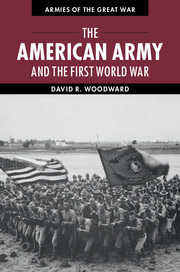Book contents
- Frontmatter
- Dedication
- Contents
- List of figures
- List of maps
- List of tables
- Preface
- List of abbreviations
- Introduction
- 1 Birth of a modern army
- 2 World war and American preparedness
- 3 Coercive power and Wilsonian diplomacy
- 4 “You’re in the army now”
- 5 US army doctrine and industrialized trench warfare
- 6 Over where?
- 7 American Expeditionary Force organization, overseas training, and deployment
- 8 Will the Americans arrive in time?
- 9 Failed expectations: “the military establishment of the United States has fallen down”
- 10 Atlantic ferry
- 11 Neck of the bottle
- 12 Uncertain times
- 13 Cantigny
- 14 Into the breach
- 15 American soldiers in north Russia and Siberia
- 16 The beginning of the end
- 17 Establishment of the American First Army and Saint-Mihiel
- 18 Meuse-Argonne, September 26–October 31
- 19 Breakout, November 1–11
- 20 Epilogue
- Notes
- Bibliography
- Index
Introduction
Published online by Cambridge University Press: 05 July 2014
- Frontmatter
- Dedication
- Contents
- List of figures
- List of maps
- List of tables
- Preface
- List of abbreviations
- Introduction
- 1 Birth of a modern army
- 2 World war and American preparedness
- 3 Coercive power and Wilsonian diplomacy
- 4 “You’re in the army now”
- 5 US army doctrine and industrialized trench warfare
- 6 Over where?
- 7 American Expeditionary Force organization, overseas training, and deployment
- 8 Will the Americans arrive in time?
- 9 Failed expectations: “the military establishment of the United States has fallen down”
- 10 Atlantic ferry
- 11 Neck of the bottle
- 12 Uncertain times
- 13 Cantigny
- 14 Into the breach
- 15 American soldiers in north Russia and Siberia
- 16 The beginning of the end
- 17 Establishment of the American First Army and Saint-Mihiel
- 18 Meuse-Argonne, September 26–October 31
- 19 Breakout, November 1–11
- 20 Epilogue
- Notes
- Bibliography
- Index
Summary
Despite its expanding population and booming economy, the United States had the smallest armed force of any major power prior to World War I, essentially an Indian constabulary. It is true that prewar reforms had federalized the National Guard, providing for a more ready and better-trained reserve, created a General Staff, and established an enhanced system of officer education that included the War College. This provided the framework for a modern military force, but the American public continued to associate universal military service and large and well-armed forces with militarism. With an authorized strength of only 3,820 officers and 84,799 men, the volunteer US Army consequently did not possess either the manpower or the modern weaponry to conduct a campaign in Europe, much less against a great power such as Germany, when the United States entered the war in April 1917.
Many Americans initially hoped to wage war against Berlin with the country’s navy, finances, and industrial, agricultural, and natural resources such as oil. But it soon became obvious that soldiers must be dispatched to European battlefields.
- Type
- Chapter
- Information
- The American Army and the First World War , pp. 1 - 3Publisher: Cambridge University PressPrint publication year: 2014



